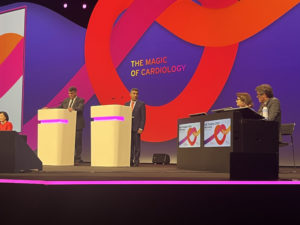Which stories, features and interviews captured the attention of the cardiovascular community across 2022? Read our summary of the trending stories from across the Cardiovascular News network throughout the year.
What were your highlights? Leave a reply in the comment box at the foot of the page with your comments.
Top stories 2022
ESC 2022: REVIVED data show PCI does not benefit patients with severe left ventricular dysfunction

Long-anticipated results from REVIVED-BCIS2—a randomised trial of percutaneous coronary intervention (PCI) versus optimal medical therapy for severe ischaemic cardiomyopathy—were delivered at the European Society of Cardiology annual congress (ESC 2022; 26–29 August, Barcelona, Spain) to a packed arena.
Trialists found that PCI did not reduce all-cause mortality or heart failure hospitalisations among patients with severe left ventricular dysfunction and extensive coronary artery disease, a finding that drew audible surprise from the ESC audience. The implications of the trial’s conclusions continue to be dissected, and data from the trial will again be in the spotlight when investigators present findings of the effect of myocardial viability, PCI and functional recovery on clinical outcomes at the American College of Cardiology (ACC) 2023 annual meeting in March (4–6 March, New Orleans, USA).
PROACT clinical trial results published for On-X mechanical mitral valve
Results of the PROACT clinical trial, published in The Annals of Thoracic Surgery in February 2022, showed no differences in bleeding, valve thrombosis, or thromboembolism rates between patients treated with low-dose versus standard-dose warfarin after On-X (Artivion) mechanical mitral valve replacement.
“We believe this research represents one of the most important advances in the clinical management of mechanical mitral valves over the past two decades and will potentially have important practice and guideline changing implications,” said trial investigator Michael WA Chu (Western University, London, Canada).
AATS and STS opt not to endorse joint coronary revascularisation guidelines
The year began in controversial fashion, with the American Association for Thoracic Surgery (AATS) and The Society of Thoracic Surgeons (STS) opting not to endorse new joint guidelines for coronary artery revascularisation, issued late the previous year by three major cardiology bodies.
Expanding on their reasoning for the rebuttal, authors of a paper in The Annals of Thoracic Surgery wrote that the new guidelines did not reflect their interpretation of the best treatment for patients with ischaemic heart disease.
“TAVI was my baby, now it is a teenager”

A founding father of transcatheter aortic valve implantation (TAVI)—Henning Rud Andersen (Aarhus University Hospital, Aarhus, Denmark)—spoke to Cardiovascular News in May, recounting the story of the development of the first prototype TAVI valve.
Though 2022 marked 20 years since the first-in-man TAVI implant, Andersen turned the clock back further, to 1989, to discuss his initial inspiration for a balloon-expandable device to percutaneously implant a heart valve, as well as the challenges he faced in getting the idea recognised, and taking it to market.
 Vijay Kunadian (Newcastle University and Newcastle upon Tyne Hospital NHS Foundation Trust, Newcastle upon Tyne, UK) was the second of four cardiovascular specialists to feature in the ‘Profile’ section of Cardiovascular News, opening up about her early career in interventional cardiology, the need for more concerted effort to improve outcomes among women with cardiovascular disease, and her research among elderly patients suffering from acute coronary syndromes.
Vijay Kunadian (Newcastle University and Newcastle upon Tyne Hospital NHS Foundation Trust, Newcastle upon Tyne, UK) was the second of four cardiovascular specialists to feature in the ‘Profile’ section of Cardiovascular News, opening up about her early career in interventional cardiology, the need for more concerted effort to improve outcomes among women with cardiovascular disease, and her research among elderly patients suffering from acute coronary syndromes.
“We have been talking about the fact that women are undertreated and have worse outcomes for decades, but have not really seen much change to improve outcomes,” she lamented. “Even in 2022, papers are being published showing that women are undertreated for the various cardiovascular conditions leading to worse outcomes.”










